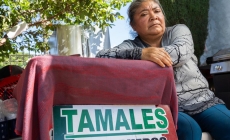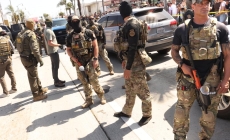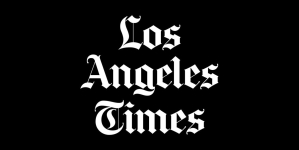-
Dozens Are Killed at Aid Site Near Border, Gaza Health Officials Say - 1 day ago
-
30 hurt when car slams into crowd in Hollywood - July 19, 2025
-
Astronomer CEO Andy Byron Placed on Leave After Video at Coldplay Concert Exposes Alleged Affair - July 19, 2025
-
Blood in the Streets and Death in the Air: Residents Survey Damage in Syrian City - July 17, 2025
-
Army vet calls for investigation after being detained for three days in ICE raid - July 17, 2025
-
Tariffs Push Up Prices, and the Supreme Court’s ‘Shadow Docket’ - July 16, 2025
-
ICE arrested her selling tamales at Lowes. Then she suffered a heart attack. ‘I told them: I can’t breathe’ - July 14, 2025
-
The Royal Box: Who’s in Wimbledon’s Most Exclusive Seats? - July 13, 2025
-
David Gergen, Adviser to Presidents and Political Commentator, Dies at 83 - July 12, 2025
-
Federal judge temporarily halts alleged indiscriminate immigration stops - July 12, 2025
California is building the bullet train, so let’s make it work
SACRAMENTO —
Gov. Gavin Newsom got the Christmas present he desperately wanted from President Biden: the crucial piece of a train set.
It’s a relatively small piece that’s vital to eventually making this fancy electric train work.
I’m referring to the much-maligned bullet train that three California governors have been trying to build .
When complete, it will carry passengers from Los Angeles to San Francisco in less than three hours at speeds of up to 220 mph. That’s the sales pitch, anyway.
Biden’s gift is a $3.1-billion grant that’s badly needed to continue work on the high-speed rail line’s initial segment in the San Joaquin Valley.
The ambitious project has been widely lampooned over the years by many, including me, as a too-costly boondoggle and off track from the start.
But let’s get real: This giant adult toy is going to be constructed one way or another, whether at reasonable speed or in pokey chug-chug fashion. It’s time we acknowledge that and focus on making it work the best for everyone. And sooner the better.
You don’t spend $11 billion on a project, as California already has, then abandon it.
Critics consistently have asserted that bullet train money should be shifted to more essential projects — reducing homelessness, educating kids, widening freeways. But that’s practically impossible. Most bullet train money — state bonds and federal grants — can be used only for high-speed rail.
Ardent supporters just as erroneously constantly point out that California is the world’s fifth-largest economy. And if nations with smaller economies — in Europe and Asia — can afford bullet trains, they argue, California certainly can.
Wrong. Those are nations, not states. They heavily subsidize high-speed rail and can do that because their purse strings are much looser. States have budget-balancing requirements. And they can’t print money.
It would be politically impossible for California alone to finance the Los Angeles-to-San Francisco high-speed rail line that’s currently projected to cost a gargantuan $110 billion. And that estimate keeps growing. It’s now roughly three times what voters were told the line would cost when they approved a nearly $10-billion bond issue for the bullet train in 2008.
“The longer it takes to build, the more expensive it is,” says Brian Kelly, chief executive officer of the California High-Speed Rail Authority.
“But it’s a lot cheaper than expanding freeways and airports.”
Could the work already done be converted to use by conventional, non-electrified passenger trains? That would be a lot less expensive.
“I suppose so,” Kelly says. “But to continue to run yesterday’s technology would not be in the state’s interest. It would be a disaster.”
The appeal of electrified trains — besides their zippy speed — is that they burn clean energy, not climate-warming fossil fuels.
But like bullet trains in Europe and Asia, California’s need generous federal funding — lots of it.
Several years ago, the feds gave California $3.5 billion for the project. That’s long gone. And it’s all the money Washington has sent — in no small part because former Republican House Speaker Kevin McCarthy of Bakersfield hated the bullet train because its tracks cut through his constituents’ farm fields.
But now, Biden’s Christmas present to Newsom will allow him to continue erecting the project’s first 171-mile segment from Merced to Bakersfield. The line is supposed to be operational by 2030.
“The train to nowhere,” critics long have cried.
“That’s wrong and offensive,” Newsom responded in his first State of the State Address in 2019. “The people of the Central Valley … deserve better.”
A 2022 poll by the UC Berkeley Institute of Governmental Studies found wide public support for continuing to build the rail line regardless of whether it initially operates only in farm country. Among registered voters, 56% favored it, with 35% opposed.
But there was a huge partisan difference: 73% of Democrats favored construction and 66% of Republicans were opposed.
Newsom said the federal gift amounts to “a vote of confidence … and comes at a critical turning point, providing the project new momentum.”
OK, but the question still remains: Why would anyone bother to take a bullet train from Merced to Bakersfield?
Kelly answers that Amtrak already draws 1.5 million passengers annually in the valley. And high-speed rail is projected to attract 7 million.
The next links will be into the San Francisco Bay Area by 2033 — it’s promised — and later into Los Angeles and Anaheim. No one has a clue when the entire line will be complete.
The total projected cost of just the San Joaquin Valley line is up to $32 billion. That money is far from lined up.
Kelly’s goal is to get an additional $5 billion from the same kitty that provided the Christmas gift: the $1.2-trillion infrastructure package that Biden pushed through Congress and signed in 2021.
Newsom’s rail project simultaneously got a second boost from the Biden administration — indirectly, at least — when it approved a $3-billion grant for a planned bullet train between Las Vegas and Southern California.
Kelly intends to connect California’s bullet train to the Vegas line and make it easier for Central Valley residents to travel by rail to Sin City.
“This is a great opportunity for high-speed rail — to buy trains together and be more efficient,” Kelly says.
But California’s electric train remains tens of billions of dollars short of enough money for completion — with no additional dollars in sight.
Private investors haven’t shown any interest. It’s doubtful California taxpayers would dig deeper. Washington is where the money is. How does Sacramento keep tapping into its vaults?
“What they really want to see is people working,” Kelly says. “We’ve got to keep grinding, keep advancing.”
If Newsom’s a good boy, maybe Washington’s Santa will give him another piece of the train set next Christmas.
Source link











